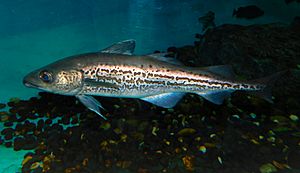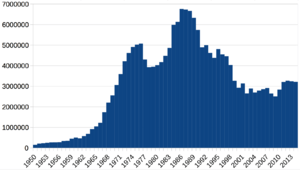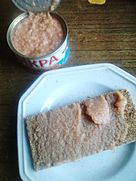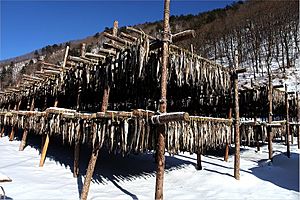Alaska pollock facts for kids
Quick facts for kids Alaska pollock |
|
|---|---|
 |
|
 |
|
| Scientific classification | |
| Synonyms | |
|
The Alaska pollock (Gadus chalcogrammus), also known as walleye pollock, is a type of fish that lives in the ocean. It belongs to the cod family. This fish often swims in large groups, called schools, in the open waters of the North Pacific. You can find the biggest groups of Alaska pollock in the eastern Bering Sea.
Contents
About the Alaska Pollock's Name
For a long time, the Alaska pollock had its own scientific name, Theragra chalcogramma. But in 2008, scientists discovered it is very closely related to the Atlantic cod. Because of this, its name was changed back to Gadus chalcogrammus. This is the name it had when it was first discovered.
The common names "Alaska pollock" and "walleye pollock" can be a bit confusing. Even though it's called a "pollock," it's not in the same group as the Atlantic pollock. Instead, it's a true cod, part of the Gadus family. Some experts think its common name should change to show it's a cod, perhaps "snow cod" or "bigeye cod." However, the old names are still widely used.
Scientists also found that a rare fish called the Norway pollock (Theragra finnmarchica), found in Norwegian waters, is actually the same species as the Alaska pollock.
Life in the Ocean: Alaska Pollock Ecology
The Alaska pollock has a speckled pattern on its body. This helps it blend in with the sandy ocean floor, making it harder for predators to spot. These fish grow fairly quickly and don't live as long as some other fish. They are a very important part of the Bering Sea ecosystem.
Interestingly, more Alaska pollock are caught three years after stormy summers. This is because storms stir up nutrients in the water. These nutrients help tiny ocean plants, called phytoplankton, grow abundantly. More phytoplankton means more food for young pollock, helping more of them survive.
Like many cod species, Alaska pollock have special muscles that help them make sounds. They use these "drumming muscles" during courtship.
How Alaska Pollock Find Food
How an Alaska pollock finds food depends on its age. Young pollock under 60 millimeters (about 2.4 inches) mainly eat tiny crustaceans called copepods. Larger young pollock, over 60 millimeters, also eat copepods but add krill to their diet. This means smaller pollock are more affected if food becomes scarce.
The size of young pollock also affects how they eat during different seasons. In winter, when food is harder to find, hunting can be risky because it increases the chance of meeting a predator. Larger young pollock can store more energy, so they don't need to hunt as much in winter. Smaller fish, however, must keep foraging, which puts them at greater risk. To survive, large pollock eat a lot in autumn to gain weight. Smaller ones focus on growing in size.
Alaska pollock also move up and down in the water during the day. This is called diel vertical migration. They follow their food sources. For example, in August, when food is plentiful near the surface, pollock will be found in shallower waters. In November, they move deeper, following their plankton food.
Where Alaska Pollock Live
Alaska Pollock in the Pacific Ocean
The main homes for Alaska pollock are the coastal areas of the Northern Pacific Ocean. This includes waters off Alaska (like the Eastern Bering Sea, Gulf of Alaska, and Aleutian Islands). They also live off the coasts of Russia, Japan, and Korea (in the Western Bering Sea and Sea of Okhotsk). The largest groups of Alaska pollock are found in the eastern Bering Sea.
Small Groups in the Arctic Ocean
Very small groups of fish that are genetically the same as Alaska pollock are found in the Barents Sea. This sea is located off northern Norway and Russia. This fish was first described as its own species, Theragra finnmarchica, in 1956. It was commonly called the "Norway pollock." However, genetic tests have shown that it is exactly the same as the Alaska pollock. So, it is now considered to be the same species, Gadus chalcogrammus. We don't know much about how this species came to be in the Barents Sea.
The first time the Norway pollock was identified as a separate species was based on two fish caught in Norway in 1932. Scientists noticed some differences in their appearance. However, later genetic studies compared the DNA of Norway pollock and Alaska pollock. These studies found no important genetic differences between them. This means they are the same species. These studies also showed that both the Alaska and Norway pollock are closely related to the Atlantic cod. This is why they were moved into the Gadus genus.
Catching Alaska Pollock: Fisheries
The Alaska pollock is a very important fish for food around the world. About 3 million tonnes of Alaska pollock are caught each year in the North Pacific. This area stretches from Alaska to northern Japan. It is the second most caught fish species globally.
In the U.S., Alaska pollock catches are the largest of any single fish species. The average catch in the Eastern Bering Sea between 1977 and 2014 was about 1.174 million tonnes. The amount of fish allowed to be caught each year is adjusted based on scientific studies of the fish population. For example, when the fish population went down in 2008, less fish were allowed to be caught in 2009 and 2010.
Some groups, like Greenpeace, have concerns about how Alaska pollock are managed. They worry about damage to the seabed from trawling, which is a fishing method. However, other groups praise the fishery for good management. The Marine Stewardship Council has even said it is "sustainable." This means the fish are caught in a way that helps keep their populations healthy for the future.
Alaska Pollock as Food
Compared to other cod and pollock species, Alaska pollock has a milder taste. It is also whiter in color and has less oil.
Fish Fillets
High-quality Alaska pollock fillets are often frozen into large blocks. These blocks are then used to make popular breaded and battered fish products in Europe and North America. Lower-quality fillets or small pieces can also be frozen into blocks. These are used to make less expensive products like fish sticks.
Alaska pollock is often used in fast food. You might find it in sandwiches like the McDonald's Filet-O-Fish.
Surimi
Alaska pollock is considered the best fish to make surimi. Surimi is a paste made from fish meat. The most common use of surimi in the United States is to make imitation crabmeat.
Pollock Roe
Pollock roe (fish eggs) is a popular food in Korea, Japan, and Russia. In Korea, it's called myeongnan. Salted roe is called myeongnan-jeot. In Japan, it's known as mentai-ko. A milder version is called tarako. In Russia, pollock roe is often eaten as a sandwich spread. It's sold in cans and looks like a liquid paste.
How Koreans Use Alaska Pollock
Alaska pollock is considered the "national fish" of Korea. The Korean name for the fish is myeongtae. This name has spread to other countries, like Russia (mintay) and Poland (mintaj). In Korea, myeongtae has many different names depending on how it's prepared. For example, saengtae is fresh pollock, dongtae is frozen, and bugeo is dried. Hwangtae is pollock dried in winter with repeated freezing and thawing.
Koreans have eaten Alaska pollock since the Joseon era. In 1940, over 270,000 tonnes of Alaska pollock were caught in the Sea of Japan (East Sea). Today, South Korea mostly imports Alaska pollock from Russia. This is because rising sea temperatures have reduced the number of pollock in Korean waters. In 2019, South Korea stopped all pollock fishing to help the fish populations recover.
Images for kids
-
Pollock larvae
See also
 In Spanish: Abadejo de Alaska para niños
In Spanish: Abadejo de Alaska para niños









